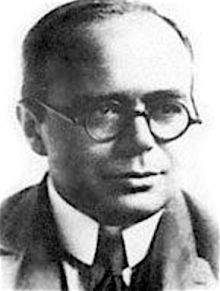
Adolf Peter Rading [commonly known as Adolf Rading; also known as Adolph Rading] was born in Berlin, Germany, on 2 March 1888. After leaving school, he served an apprenticeship as a bricklayer and attended the Städtische Baugewerkeschule in Berlin from 1905 to 1908. He then worked as an assistant in the offices of Peter Behrens (1868–1940), Albert Gessner (1868–1953) and August Endell (1871–1925).
From 1914 to 1918 he did military service and in 1919 worked briefly in Behrens' office. Later that year he he was invited to teach at the Akademie für Kunst und Kunstgewerbe in Breslau, Germany [now Wroclaw, Poland] where he had been director since 1918. In 1923 Rading was appointed professor and head of the building class and workshops. Rading taught at the Akademie until it closed in 1932. In 1922 he carried out the conversion of a row of houses in the Oranienstrasse in Breslau. He also remodelled the ‘Mohren Apotheke’, the old Moorish dispensary in Breslau.
From 1926 he ran a joint architectural office in Berlin with Hans Scharoun (1893–1972. In the late 1920s Rading also worked with Oskar Schemmer (1888-1943). They collaborated in the design of a house in Zwenkau, Germany, built between 1929 and 1931. Rading also joined the Deutscher Werkbund and participated in its exhibitions in Stuttgart-Weißenhof and in Breslau. He also joined the architectural association Der Ring and was a member of the Reichsforschungsgesellschaft für Wirtschaftlichkeit im Bau- und Wohnungswesen.
A residential complex in the the Rummelsburg district of Berlin, built between 1930 and 1933, was probably Rading's last architectural project in Germany. When the National Socialists came to power in 1933, Rading and his wife, who was from a Jewish family, moved France. They briefly ran a farm before emigrating to Palestine, where Rading formed a partnership with Kurt Reinsch (1892–1952). In 1936 they received first prize for their urban planning design for the centre of Haifa near the port [not implemented], and in 1939 the built an apartment house in Haifa for Walter Roth.
In 1943 Rading was appointed city architect for Haifa [or architectural consultant for the city of Haifa - sources differ] and after 1945 took over the management of the urban development authority. Following changes in the building policy after the establishment of the State of Israel in 1948 he decided to leave the country. He had thought of returning to Berlin but instead emigrated to England. He settled in London and became a naturalised British citizen in 1952 and that year received accreditation from the Royal Institute of British Architects. He established an office in London with the émigré and Berlin-born Fritz Heinrich (later Frederick) Herrmann (1898–1983).
Rading is known to have designed at least four buildings in England. He died in London on 4 April 1957.
Stortkuhl, Beate. Der Architekt Adolf Rading (1888-1957): Arbeiten in Deutschland bis 1933. Munich: Tuduv-Verl.-Ges., 1992.